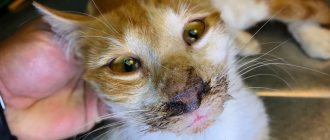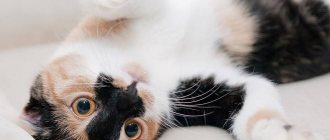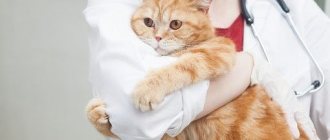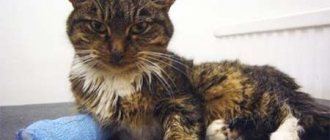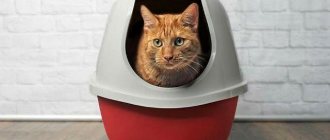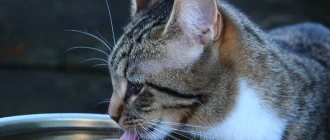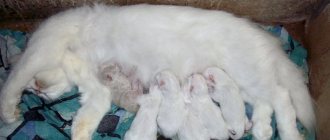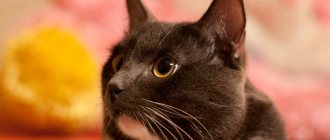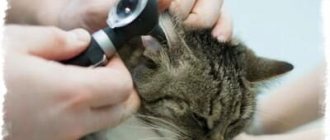Pancreatitis is an inflammatory process in the pancreas in cats, which, if not properly treated, ends in death. Unfortunately, at the initial stage of this disease, characteristic signs are most often absent. Therefore, in order to provide first aid to the pet in a timely manner, the owner needs to know what the symptoms are and how pancreatitis in cats is treated.
The role of the pancreas in the animal body
The pancreas in cats is an organ of the digestive system that performs endocrine and exocrine functions.
Endocrine functions are expressed in the synthesis of hormones that regulate carbohydrate metabolism by increasing or decreasing the concentration of glucose in the blood and tissues. These hormones include insulin and glucagon.
The exocrine function is to produce pancreatic juice, which contains enzymes for the digestion of proteins, lipids and carbohydrates.
During normal functioning of the organ in cats, the secretion of the pancreas is secreted into the duodenum, where it acts on the food bolus that comes from the stomach. However, when the gland ducts are blocked as a result of inflammation, tumor or other factors, active enzymes begin to digest their own tissues. Involvement of pathogenic microflora in the pathological process quickly leads to the development of sepsis, which causes death in cats.
Good to know
- Antiemetic pharmacological agents - Antiemetics - Dopamine receptor antagonists in dogs and cats
- Anal atresia in cats (Atresia ani)
- Brachycephalic syndrome in cats
- Gastroprotectors of the group of prostaglandin analogues and the mucosal protector sucralfate in dogs and cats
- Antiemetics – Phenothiazines – Antiemetics for the treatment of dogs and cats
- IBD in cats. Inflammatory bowel disease in cats
- Lack of molecular epidemiological data supporting domestic animal transmission of zoonotic Giardia duodenalis and Cryptosporidium spp. from domestic dogs and cats
Causes of pathology
The most common form of pancreatitis in cats is often idiopathic. The following causes of this disease of the pancreas in cats, sometimes provoked by diseases of adjacent organs, are also identified:
- injuries resulting from falls from great heights, impacts, compression;
- surgical intervention;
- toxoplasmosis;
- viral feline peritonitis;
- feline viral immunodeficiency;
- pancreatic lipodystrophy;
- poisoning with organophosphorus compounds;
- hypercalcemia;
- long-term uncontrolled use of aspirin.
Note! For a long time, it was believed that obesity, excess fatty foods in a pet's diet, the use of glucocorticoids and diabetes mellitus are predisposing factors that contribute to the development of pancreatitis in cats. However, recent studies have shown that these risk factors are characteristic of dogs, but are not related to inflammation of the pancreas in cats.
Also controversial is the issue of the development of feline pancreatitis due to hepatitis and inflammatory diseases of the gastrointestinal tract. Modern scientific data prove that these diseases, on the contrary, are a consequence of pathologies of the pancreas.
In kittens, pancreatitis can develop due to the introduction of infectious agents, trauma or congenital pathologies.
Risk factors
Often, veterinarians cannot determine the true cause of the disease, considering it idiopathic. In most cases, pancreatitis is the result of an unsuccessful operation or injury to the peritoneal area.
Cats that have had toxoplasmosis, infectious peritonitis or immunodeficiency virus are also at risk.
Some medications that cause poisoning in pets can cause the development of dangerous pathologies. For example, the prescription of aspirin or organophosphate poisoning.
Clinical symptoms
Pancreatitis in cats can manifest itself in acute and chronic forms. They have significant differences in the rate of progression and symptoms. Sometimes it is very difficult for owners to understand that a cat has serious problems with the pancreas, since the clinical signs of chronic pancreatitis are often manifested only by drowsiness, rumbling in the stomach and rare bowel movements. There are times when a cat begins to hide or deliberately leave the house. This behavior is caused by the instinct of self-preservation, when the animal needs to find a reliable shelter from enemies during the illness.
Important! If the owner notices lethargy, drowsiness, or a change in the eating habits of his pet, he needs to contact a veterinarian for a full examination of the cat’s internal organs and systems.
Acute form
The main clinical signs and symptoms of acute pancreatitis in a cat, based on which a veterinarian prescribes treatment, are:
- vomiting (appears during an attack and does not bring relief to the pet);
- uncontrollable diarrhea;
- the presence of undigested food particles in the feces;
- sour smell coming from feces;
- yellowness of the mucous membranes;
- anorexia;
- tense abdominal wall;
- pain in the abdominal area;
- dry mucous membranes;
- increased body temperature;
- shortness of breath or rapid breathing caused by pain.
Important! During an attack of acute pancreatitis, cats experience such severe pain that even a very peaceful pet can bite the owner if he tries to touch his stomach or ribs.
A characteristic symptom of pancreatitis is lethargy, which occurs in 80-100% of cases. This term in cats refers to sleeping longer than usual. Together with anorexia, it should cause anxiety among owners and become a reason to contact the clinic.
Treating acute pancreatitis at home in a cat is impossible. The animal must be taken to a veterinary clinic immediately.
Chronic form
Chronic pancreatitis in cats can manifest itself as an independent disease, as well as be a consequence of the acute form.
The development of chronic pancreatitis is slow, and in the first stages it does not manifest clinical signs. The cat may periodically experience lethargy, apathy, vomiting and constipation. But after a few days, these symptoms disappear, and the owners attribute this to a temporary illness for unexplained reasons.
However, irreversible processes in the pancreas do not stop and lead to the destruction of a significant volume of the organ. The cat's appetite decreases significantly, its fur becomes dull, and lethargy sets in. When more than 60% of the gland is affected, pancreatitis in a cat becomes acute and manifests itself as a severe attack.
How to treat?
It is necessary to begin treating your pet immediately after diagnosis. If you notice that your pet is showing a gag reflex immediately after drinking or eating, then mention this to your veterinarian, as you need to find the reason for this.
If not found, then there is a possibility that treatment will be completely useless. You will have to give the cat special medications. If the symptoms are not severe, then special medications are also given.
Methods for diagnosing pancreatitis in cats
The subtle symptoms of pancreatitis in cats often do not allow specialists to identify the disease based only on the results of anamnesis, examination, palpation and thermometry. Therefore, additional laboratory and instrumental tests are prescribed to help make an accurate diagnosis and properly treat pancreatitis in a cat.
- A clinical blood test for pancreatitis in cats reveals an increased content of leukocytes and young red blood cells per unit volume of pathological material.
- A biochemical blood test shows elevated levels of glucose, liver enzymes, bilirubin, alkaline phosphatase, as well as decreased levels of calcium and potassium.
- Ultrasound of the abdominal cavity makes it possible to establish an enlargement of the lobes and main duct of the pancreas, diffuse blurring of the contours of the affected organ, and increased echogenicity of the parenchyma. Experts also observe thickening of the walls of the stomach and duodenum, and an increase in the volume of the gallbladder.
- CT scanning is rarely used to detect pancreatitis in cats. This is due to the special location of the pancreas, which does not allow high-quality visualization of the organ.
- Biopsy and histological examination of pathological material are the most accurate and informative methods for diagnosing pancreatitis in cats. However, obstacles to its implementation may be the impossibility of administering anesthesia, the high probability of death during surgery, or the high cost of the procedure.
- Tests to determine the level of pancreatic lipase and trypsin-like immunoreactivity in cats, the reliability of which ranges from 83 to 100%.
Note! If a biopsy is chosen as a diagnostic method for pancreatitis in cats, the specialist may suggest simultaneous collection of pathological material from the liver and intestines. This will allow us to get a complete picture of the pathology and develop more effective and comprehensive treatment.
Prices for appointments in our clinics
| Name of veterinary services | Unit | Price, rub |
| ⭐ Initial appointment | 1 animal | 400 |
| ⭐ Repeated appointment | 1 animal | 250 |
| Initial appointment with a specialist | 1 animal | 1100 |
| Consultation without an animal | — | 550 |
| Consultation with a doctor based on test results | 1 PC. | 400 |
| Weighing animals | 1 animal | For free |
| Additional fixation for aggressive animal behavior | 1 animal | 700 |
Treatment of pancreatitis in cats
The treatment regimen for pancreatitis in cats is developed individually for each animal, depending on the symptoms, form and severity of the disease.
If a cat is brought to the clinic with an attack of acute pancreatitis, the specialist will prescribe treatment, the purpose of which will be:
- pain relief (morphine derivatives);
- elimination of spasm (No-shpa, Papaverine);
- prevention of dehydration and intoxication (injection of isotonic solution or Ringer's solution);
- stopping vomiting (Cerucal, Metoclopramide);
- maintaining heart function against the background of blood thickening and intoxication (Cordiamin).
In cases of complete blockage of the pancreatic ducts, the veterinarian decides on the advisability of surgical intervention.
Important! For cats that come to the clinic with vomiting and other symptoms of pancreatitis, a starvation diet for 1-2 days is indicated as treatment. However, if the cat is already suffering from anorexia, then it is immediately provided with nutrition through a nasoesophageal or PEG tube.
Next, if there is no appetite, the cat is prescribed stimulants (Mirtazapine).
In severe cases, when animals develop systemic dysfunction of blood clotting against the background of acute pancreatitis, blood plasma transfusions or the administration of Dextran-70 are used (depending on the severity of the process).
Antibiotics for pancreatitis in cats are prescribed only when feline infections of bacterial etiology develop. Corticosteroid drugs (Prednisolone) are most often used to relieve inflammation.
After eliminating the attack and restoring basic body functions, it is necessary to switch the pet to a diet and give the cat Pancreatin.
Treatment of chronic pancreatitis is fundamentally different from therapy for the acute form of the disease. In this case, measures should be aimed at maintaining the functioning of the pancreas with the help of a certain diet, the introduction of pancreatic enzymes (pancreatin), proton pump inhibitors and the elimination of concomitant pathologies of the gastrointestinal tract, liver and gall bladder.
Owners should understand that it is impossible to completely cure chronic pancreatitis in a cat. But if you know how to treat the symptoms of this disease, you can maximize the duration of the remission period and the life expectancy of your pet.
Pancreatin, when strictly observed in the dosage, dosage regimen and duration of treatment, helps to partially restore the function of the pancreas and digestive organs. This drug includes the following enzymes:
- lipase, which breaks down fats;
- alpha-amylase (takes part in the breakdown of carbohydrates);
- chymotrypsin and trypsin (decompose proteins).
According to the instructions for use of Pancreatin, it must be given to pets after feeding 3 to 4 times a day. The dosage and duration of taking the tablets is calculated by a veterinarian depending on the age, body weight of the animal and the severity of the pathology.
Complications and consequences
High mortality in the acute form is associated with early complications arising from the inflammatory process. It leads to thrombosis, internal bleeding, liver and respiratory failure.
With a prolonged course of the disease, the likelihood of developing oncology and the appearance of fistulas increases. The body's defenses gradually decline, so it becomes vulnerable to pathogenic microorganisms. In the event of a secondary infection, not only the pancreas suffers, but also the nearby intestines and other neighboring tissues. This leads to purulent abscesses, fraught with the appearance of sepsis. With this outcome, the animal may die from blood poisoning.
Another dangerous complication is pancreatic necrosis. This pathology is accompanied by the death of tissue of the affected organ and loss of its functionality. Enzymes and breakdown products entering the bloodstream aggravate intoxication. Not only the immediate organs are in danger, but also the heart and brain. In 90% of cases, pancreatic necrosis is incurable.
With late treatment, the acute form develops into a chronic form. Like pancreatic necrosis, it is incurable. Treatment is based on symptomatic therapy, lifelong diet and regular prevention.
Feeding cats with pancreatitis
It should be understood that this disease is incurable, so periods of stable remission will alternate with relapses. To prevent their frequent recurrence and prolong the cat’s full life, it is necessary to undergo regular preventive examinations, as well as change the principles and diet of the animal.
Diet plays a fundamental role in your pet's recovery during the treatment of symptoms of pancreatitis in cats and during the recovery period. Therefore, owners must adhere to the following feeding principles:
- minimizing the volume of portions;
- increasing the frequency of feedings up to 4-6 times a day;
- feeding with warm soft food (pates, purees, canned food);
- Ensuring that your cat gets enough water;
- gradual introduction of new foods into the diet.
Important! If, after introducing a new product to food, your pet experiences stool problems or a deterioration in its general health, you should immediately stop feeding it and consult a veterinarian.
The list of prohibited products for pancreatitis includes:
- raw vegetables and fruits;
- products that cause fermentation (cabbage, potatoes, baked goods);
- boiled chicken eggs;
- whole grain cereals;
- fatty fish and meats;
- whole milk;
- offal;
- confectionery and sweets;
- smoked meats, sausages, fish and meat pickles;
- fried foods;
- canned food intended for human nutrition.
Note! Corn is also on the list of prohibited foods. But it forms the basis of most industrial feeds of economy and premium class. Therefore, cats suffering from pancreatitis must be switched to holistic or super premium food. But you should also carefully study their composition indicated on the packaging.
Correctly removing a cat from a starvation diet consists of certain stages.
| Recovery stages | Nutrition principles and permitted foods |
| 1-2 days after fasting | Liquid porridge from ground cereals (rice, buckwheat) in water, 1 tbsp. l. 5-6 times a day |
| 3-4 day | Steamed protein omelet, porridge, boiled carrot or zucchini puree 50 g 4-5 times a day |
| 5-7 day | Low-fat fermented milk products, porridge with diluted milk (1:3) |
| Next up to 30 days | Puree from boiled dietary meat and fish with the addition of 2-3 drops of vegetable oil |
If the cat’s digestion has recovered within a month, then you should contact a veterinarian, undergo an examination and receive instructions on further principles of the diet.
Important! Even with persistent remission of pancreatitis, cats should not be given prohibited foods.
Prevention measures
To prevent pancreatitis in cats, the following rules must be followed:
- Do not feed your cat prohibited foods;
- control the animal’s weight to prevent the development of obesity;
- avoid injuries and falls;
- introduce mineral and vitamin supplements into the diet;
- eliminate the risk of poisonous and toxic substances entering the pet’s body, including poisonous indoor plants;
- carry out routine treatments and vaccinations in a timely manner;
- provide sufficient physical activity.
You should always remember that the mortality rate of acute pancreatitis in cats reaches 80%, since many owners do not promptly contact a veterinary clinic for help. When the first alarming symptoms appear, your pet should undergo an examination to exclude or confirm the presence of pathology. However, it is worth understanding that pancreatitis is easier to avoid through preventative measures than to subsequently treat and follow a strict diet for the rest of the cat’s life.
